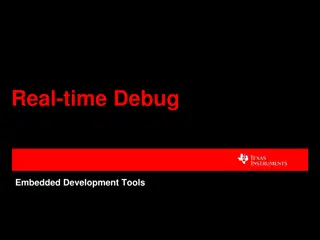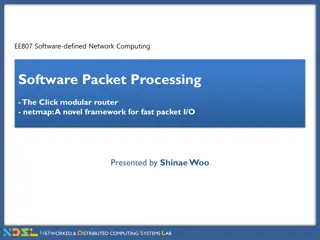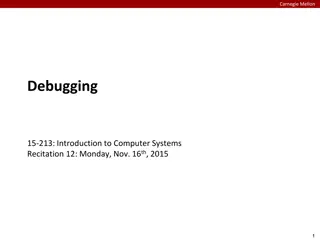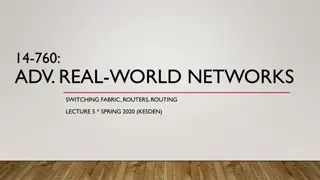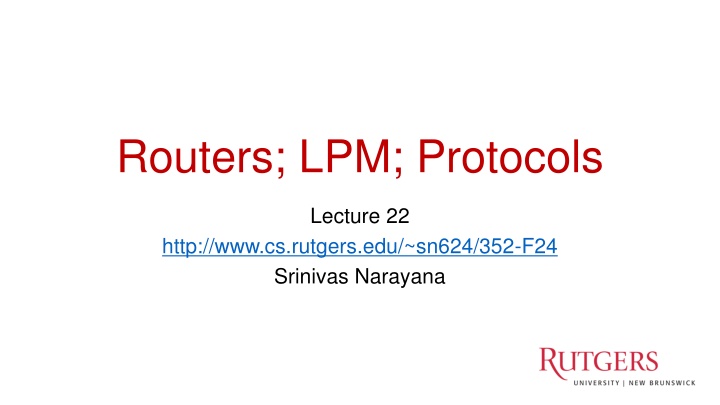
Router Architecture and Switching Fabrics in Network Protocols
Explore the intricacies of router architecture and switching fabrics in network protocols, including the role of input and output ports, nonblocking fabrics, and the functionalities of control and data planes. Discover how modern high-speed routers optimize shared-memory interconnects for efficient data transmission.
Download Presentation

Please find below an Image/Link to download the presentation.
The content on the website is provided AS IS for your information and personal use only. It may not be sold, licensed, or shared on other websites without obtaining consent from the author. If you encounter any issues during the download, it is possible that the publisher has removed the file from their server.
You are allowed to download the files provided on this website for personal or commercial use, subject to the condition that they are used lawfully. All files are the property of their respective owners.
The content on the website is provided AS IS for your information and personal use only. It may not be sold, licensed, or shared on other websites without obtaining consent from the author.
E N D
Presentation Transcript
Routers; LPM; Protocols Lecture 22 http://www.cs.rutgers.edu/~sn624/352-F24 Srinivas Narayana 1
Review: Router architecture assuming distributed routing, routing function: decide which ports packets need to exit route processor Control plane Data plane Forwarding function: move packets from one input port to another. high-speed switching fabric router output ports router input ports
Input port Output port Fabrics: Types Switching fabric Input port Output port Fabric goal: Ferry as many packets as possible from input to output ports as quickly as possible. Input port Output port Input port writes packets into shared memory. Output port reads the packet when output link ready to transmit. Each input port has a physical data path to every output port. Switch at the cross-over points turns on to connect pairs of ports. Single shared channel to move data from input to output port. Easy to build buses; technology is quite mature.
Input port Output port Fabrics: Types Switching fabric Input port Output port Input port Output port Crossbars can get expensive as the number of ports grows (N2 connections for N ports) MGR uses a crossbar and schedules (in,out) port pairs. Modern high-speed routers use highly optimized shared- memory-based interconnects.
Input port Output port Nonblocking fabrics Switching fabric Input port Output port Input port Output port High-speed switching fabrics designed to be nonblocking: If an output port is available , an input port can always transmit to it without being blocked by the switching fabric itself Nontrivial to achieve Crossbars are nonblocking by design Shared memory can be designed to be nonblocking if memory accesses can be made fast enough
Input port Output port Nonblocking fabrics Switching fabric Input port Output port Input port Output port With a nonblocking fabric, queues aren t formed due to the switching fabric. With a nonblocking fabric, there are no queues due to inefficiencies at the input port or the switching fabric Queues only form due to contention for the output port Fundamental, unavoidable, given the route
Input port Output port Nonblocking fabrics Switching fabric Input port Output port Input port Output port With a nonblocking fabric, queues aren t formed due to the switching fabric. With a nonblocking fabric, there are no queues due to inefficiencies at the input port or the switching fabric Queues only form due to contention for the output port Fundamental, unavoidable, given the route Typically, these queues form on the output side But can also backpressure to the input side if there is high contention for the output port i.e.: can t move pkts to output Qs since buffers full, so buffer @ input
Control (plane) processor A general-purpose processor that programs the data plane: Forwarding table Scheduling and buffer management policy Implements the routing algorithm by processing routing protocol messages Mechanism by which routers collectively solve the Internet routing problem More on this soon. Control Processor Input port Output port Switching fabric Input port Output port Input port Output port
Router design: the bigger picture Control plane Traditional distributed routing: per route- change processing (~ a few tens of seconds) Routing Algorithm control plane data plane Data plane per-packet processing (~ tens of nanoseconds) 0111 1 2 3 values in arriving packet header, i.e, destination IP address
Review: Route lookup Table lookup matches a packet against an IP prefix Ex: 65.12.45.2 matches 65.0.0.0/8 Extract destination IP address Transport Parse Network Link layer Prefixes are allocated to organizations by Internet registries Route Lookup Data Structure Outgoing Port Forwarding Table Dst-network Port But organizations can reallocate a subset of their IP address allocation to other orgs 65.0.0.0/8 128.9.0.0/16 3 1 149.12.0.0/19 7
ISP = Internet Service Provider Example of IP block reallocation Dst IP Prefix Output port Suppose ISP A reallocates a part of its IP block to orgs 1 8 65.0.0.0/8 128.9.0.0/16 200.23.16.0/20 3 1 7 (towards A) ISP A owns the IP block 200.23.16.0/20. Organization 1 200.23.16.0/23 200.23.18.0/23 Organization 2 ... ISP A 200.23.20.0/23 Organization 3 ... Internet Organization 8 200.23.30.0/23 There is an announcement mechanism (BGP) by which ISP A can inform the rest of the Internet about the prefixes it owns. It is enough to announce a coarse-grained prefix 200.23.16.0/20 rather than 8 separate sub-prefixes. Route Aggregation Save forwarding table memory Fewer routing protocol msgs
Example of IP block reallocation Dst IP Prefix Output port Suppose ISP A reallocates a part of its IP block to orgs 1 8 65.0.0.0/8 128.9.0.0/16 200.23.16.0/20 3 1 7 (towards A) ISP A owns the IP block 200.23.16.0/20. Organization 1 200.23.16.0/23 200.23.18.0/23 Organization 2 ... ISP A 200.23.20.0/23 Organization 3 ... Internet Organization 8 200.23.30.0/23 Now suppose one of these organizations adds another ISP for its Internet service and prefers using the new ISP. Note: it s possible for the organization to retain its assigned IP block.
Example of IP block reallocation Dst IP Prefix Output port Suppose ISP A reallocates a part of its IP block to orgs 1 8 65.0.0.0/8 128.9.0.0/16 200.23.16.0/20 3 1 7 (towards A) ISP A owns the IP block 200.23.16.0/20. Organization 1 200.23.16.0/23 200.23.18.0/23 Organization 2 ... ISP A 200.23.20.0/23 Organization 3 ... Internet Organization 8 200.23.30.0/23 ISP B Organization 2 200.23.18.0/23
Example of IP block reallocation Dst IP Prefix Output port Suppose ISP A reallocates a part of its IP block to orgs 1 8 65.0.0.0/8 128.9.0.0/16 200.23.18.0/23 200.23.16.0/20 3 1 4 (towards B) 7 (towards A) ISP A owns the IP block 200.23.16.0/20. Organization 1 200.23.16.0/23 200.23.18.0/23 Organization 2 ... ISP A 200.23.20.0/23 Organization 3 ... Internet Organization 8 200.23.30.0/23 ISP B Organization 2 200.23.18.0/23
A closer look at the forwarding table Dst IP Prefix Output port 200.23.18.0/23 is inside 200.23.16.0/20 65.0.0.0/8 128.9.0.0/16 200.23.18.0/23 200.23.16.0/20 3 1 4 (towards B) 7 (towards A) A packet with destination IP address 200.23.18.xx is in both prefixes i.e., both entries match Q: How should the router choose to forward the packet? Ideally: The org prefers B, so should choose B 200.23.16.0/20 The Internet uses a policy to prioritize: Longest Prefix Matching
Longest Prefix Matching (LPM) Dst IP Prefix Output port Use the longest matching prefix, i.e., the most specific route, among all prefixes that match the packet. 65.0.0.0/8 128.9.0.0/16 200.23.18.0/23 200.23.16.0/20 3 1 4 (towards B) 7 (towards A) Policy borne out of the Internet s IP allocation model: prefixes and sub-prefixes are handed out Internet routers use longest prefix matching. How would you implement this in software? Interesting algorithmic and design challenges in developing software and hardware 200.23.16.0/20
Internet routers perform longest- prefix matching on destination IP addresses of packets.
Why is LPM useful? Help organizations move in one block to a different ISP while retaining their IP prefix assignment. IPs unchanged: e.g., don t have to update DNS for services in the org Also enable an organization (e.g. Rutgers) to connect to two or more Internet Service Providers (ISPs) and express routing preferences Announce longer prefixes to make the rest of the Internet prefer a certain path
Verizon Rutgers Why is LPM useful? AT&T An ISP (e.g., Verizon) has allocated a sub-prefix (or subnet ) of a larger prefix that the ISP owns to an organization (e.g., Rutgers) Further, the ISP announces the aggregated prefix to the Internet to save on number of forwarding table memory and number of announcements The organization (e.g., Rutgers) is reachable over multiple paths (e.g., through another ISP like AT&T) The organization has a preference to use one path over another, and expresses this by announcing the longer (more specific) prefix Routers in the Internet must route based on the longer prefix
Transport Network Link layer total datagram length (bytes) IP protocol version 32 bits number header length (bytes) type of service hdr len ver length fragment offset Bits for for fragmentation/ reassembly traffic differentiation e.g., audio, web, bulk flags 16-bit identifier time to live max number remaining hops (decremented at each router) upper protocol header checksum 32-bit source IP address 32-bit destination IP address upper layer protocol to deliver payload to, e.g., TCP, UDP E.g. timestamp, record the route taken, specify list of routers to visit ( source routing ) Options (if any) How much header overhead? (default) 20 bytes of TCP (default) 20 bytes of IP = 40 bytes data (variable length, typically a TCP or UDP segment) 22
The network layer is all about reachability. We ll see protocols that solve subproblems. How does an endpoint talk to another outside its network? Routing protocols OSPF, RIP, BGP How does an endpoint get an address? DHCP Debugging? ICMP How does an endpoint talk to another within the same network? ARP Gateways NAT & IPv6
IP Support Protocols Many support protocols and mechanisms for the network layer Protocols: DHCP, ICMP, ARP, IPv6, Mechanisms: NAT Some of these protocols use an IP header underneath their own header (ICMP) or replace the IP header with their own (ARP) But these shouldn t be construed as transport/network protocols They are fundamental to supporting IP/network layer functionality More appropriately discussed as support protocols for the network layer
Internet Control Message Protocol (ICMP)
Internet Control Message Protocol A protocol for troubleshooting and diagnostics Works over IP: unreliable delivery of packets Some functions of ICMP: Determine reachability and network errors Specify that packets have been in the network for too long
ICMP message format (informal) ICMP header Message type, Code, Checksum, ICMP data IP header https://en.wikipedia.org/wiki/Internet_Control_Message_Protocol#Control_messages 27
Specific uses of ICMP Echo request reply Check remotely if an endpoint is alive and connected Without running an app remotely or controlling that endpoint An unreachable destination Invalid address and/or port Knowing if packet s IP time-to-live expired Example, due to routing loops Look at two tools built using ICMP: ping and traceroute











